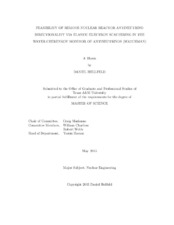| dc.description.abstract | Cubic meter sized liquid scintillator detectors have demonstrated that the operational status, power level, and changes in fuel composition of a critical nuclear reactor system can be remotely measured with the antineutrino signal. With the success of these detectors, research has been pursued in the scaling of the detector size to increase sensitivity and standoff distance. One such detector is the WATer CHerenkov Monitor of ANtineutrinos (WATCHMAN). WATCHMAN is a kiloton-scale gadolinium-doped water Cherenkov detector, surrounded by approximately 4300 30.48 cm (12 inch) photomultiplier tubes (PMTs). The detector will utilize the inverse beta decay (IBD) interaction to measure the antineutrino rate and energy spectrum approximately 13 km away from a 3.758 GW(th) nuclear reactor. WATCHMAN will be the first to demonstrate the potential of gadolinium-doped water Cherenkov detectors for future nuclear reactor monitoring and safeguards applications.
While IBD will enable WATCHMAN to measure the antineutrino rate and energy spectrum, the detector will not be sensitive enough to extract the direction of the incident antineutrinos from this process. Antineutrino directionality would be useful if multiple reactors are located near the detector, or if it is used to search for and locate clandestine reactors. This research investigated the potential of an alternative interaction, elastic antineutrino-electron scattering, to determine the direction of the incident antineutrino flux in WATCHMAN. Calculations were done to determine the expected scattering rate and Monte Carlo simulations were performed with GEANT4 to model detector response. Event reconstruction software was then used to reconstruct the directions of the scattered electrons based on the triggered PMT times, locations, and charge intensities. Estimated background rates were incorporated into the scattering signal by scaling reported measurements from similar detectors. Many potential sources of background were considered, including solar neutrinos and misidentified IBD interactions, gamma rays from the PMTs, detector walls, and surrounding rock, as well as the decays of cosmogenic radionuclides and water-borne radon. Preliminary results indicate that while most of the sources of background can be adequately controlled with strict detector component cleanliness and low radioactivity PMTs, radon levels consistent with other existing detectors are likely to exceed the acceptable limit for directional sensitivity in WATCHMAN. | en |


